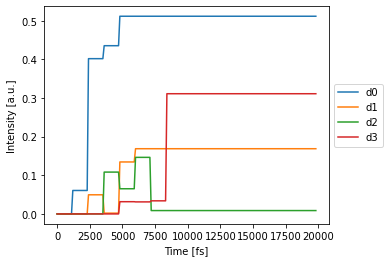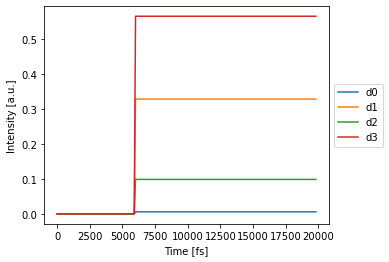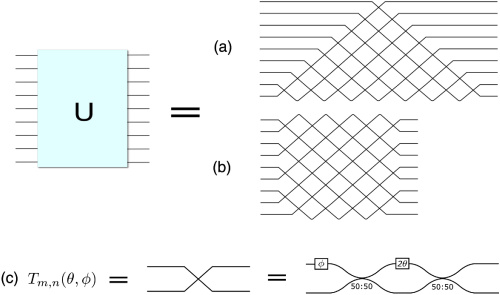Unitary Matrix Networks in the Time Domain¶
Imports¶
[1]:
# Photontorch
import photontorch as pt
# Python
import torch
import numpy as np
import matplotlib.pyplot as plt
from tqdm.notebook import trange
# numpy settings
np.random.seed(6) # seed for random numbers
np.set_printoptions(precision=2, suppress=True) # show less numbers while printing numpy arrays
Simulation and Design Parameters¶
Here we will use the matrix network with delays.
[2]:
N = 4
length = 25e-6 #[m]
transmission = 0.5 #[]
neff = 2.86
env = pt.Environment(
t_start = 0,
t_end = 2000e-14,
dt = 1e-13,
wl = 1.55e-6,
)
pt.set_environment(env)
source = torch.ones(N, names=["s"])/np.sqrt(N) # Source tensors with less than 4D need to have named dimensions.
env
[2]:
| key | value | description |
|---|---|---|
| name | env | name of the environment |
| t | [0.000e+00, 1.000e-13, ..., 1.980e-11] | [s] full 1D time array. |
| t0 | 0.000e+00 | [s] starting time of the simulation. |
| t1 | 1.990e-11 | [s] ending time of the simulation. |
| num_t | 199 | number of timesteps in the simulation. |
| dt | 1.000e-13 | [s] timestep of the simulation |
| samplerate | 1.000e+13 | [1/s] samplerate of the simulation. |
| bitrate | None | [1/s] bitrate of the signal. |
| bitlength | None | [s] bitlength of the signal. |
| wl | 1.550e-06 | [m] full 1D wavelength array. |
| wl0 | 1.550e-06 | [m] start of wavelength range. |
| wl1 | None | [m] end of wavelength range. |
| num_wl | 1 | number of independent wavelengths in the simulation |
| dwl | None | [m] wavelength step sizebetween wl0 and wl1. |
| f | 1.934e+14 | [1/s] full 1D frequency array. |
| f0 | 1.934e+14 | [1/s] start of frequency range. |
| f1 | None | [1/s] end of frequency range. |
| num_f | 1 | number of independent frequencies in the simulation |
| df | None | [1/s] frequency step between f0 and f1. |
| c | 2.998e+08 | [m/s] speed of light used during simulations. |
| freqdomain | False | only do frequency domain calculations. |
| grad | False | track gradients during the simulation |
A. Reck Design¶
[3]:
nw = pt.ReckNxN(
N=N,
wg_factory=lambda: pt.Waveguide(length=1e-4, phase=2*np.pi*np.random.rand(), trainable=True),
mzi_factory=lambda: pt.Mzi(length=1e-4, phi=2*np.pi*np.random.rand(), theta=2*np.pi*np.random.rand(), trainable=True),
).terminate()
Simulation¶
[4]:
detected_time = nw(source)
nw.plot(detected_time[:,0,:,0]); # plot first and only batch

Optimizing the coupling¶
The goal is to optimize the coupling of the network such that we have the same output at the 4 detectors with an as high as possible amplitude (ideally, higher than in the equal coupling case).
[6]:
def train_for_same_output(nw, num_epochs=50, learning_rate=0.1):
target = torch.tensor([1.0/N]*N, device=nw.device)
lossfunc = torch.nn.MSELoss()
optimizer = torch.optim.Adam(nw.parameters(), lr=learning_rate)
with pt.Environment(wl=1.55e-6, t0=0, t1=10e-12, dt=1e-13, grad=True):
range_ = trange(num_epochs)
for epoch in range_:
det_train = nw(source)[-1,0,:,0]
loss = lossfunc(det_train, target)
loss.backward()
optimizer.step()
range_.set_postfix(loss=loss.item())
train_for_same_output(nw)
Final Simulation¶
[7]:
%time det_train = nw(source)
nw.plot(det_train[:,0,:,0]); # plot first and only batch
CPU times: user 42.5 ms, sys: 77 µs, total: 42.6 ms
Wall time: 41.9 ms

Note that in the Reck network, signals arrive at different times.
B. Clements Design¶
[9]:
nw = pt.ClementsNxN(
N=N,
capacity=N,
wg_factory=lambda: pt.Waveguide(length=1e-4, phase=2*np.pi*np.random.rand(), trainable=True),
mzi_factory=lambda: pt.Mzi(length=1e-4, phi=2*np.pi*np.random.rand(), theta=2*np.pi*np.random.rand(), trainable=True),
).terminate()
Simulation¶
[10]:
detected_time = nw(source)
nw.plot(detected_time[:,0,:,0]); # plot first and only batch

Optimizing the coupling¶
[12]:
def train_for_same_output(nw, num_epochs=50, learning_rate=0.1):
target = torch.tensor([1.0/N]*N, device=nw.device)
lossfunc = torch.nn.MSELoss()
optimizer = torch.optim.Adam(nw.parameters(), lr=learning_rate)
with pt.Environment(wl=1.55e-6, t0=0, t1=10e-12, dt=1e-13, grad=True):
range_ = trange(num_epochs)
for epoch in range_:
det_train = nw(source)[-1,0,:,0] # get first and only batch
loss = lossfunc(det_train, target)
loss.backward()
optimizer.step()
range_.set_postfix(loss=loss.item())
train_for_same_output(nw)
Final Simulation¶
[13]:
%time det_train = nw(source)
nw.plot(det_train[:,0,:,0]); # plot first and only batch
CPU times: user 41.1 ms, sys: 21 µs, total: 41.1 ms
Wall time: 40.4 ms

Note that in the Clements network, all signals arrive at the same time at the detector.
